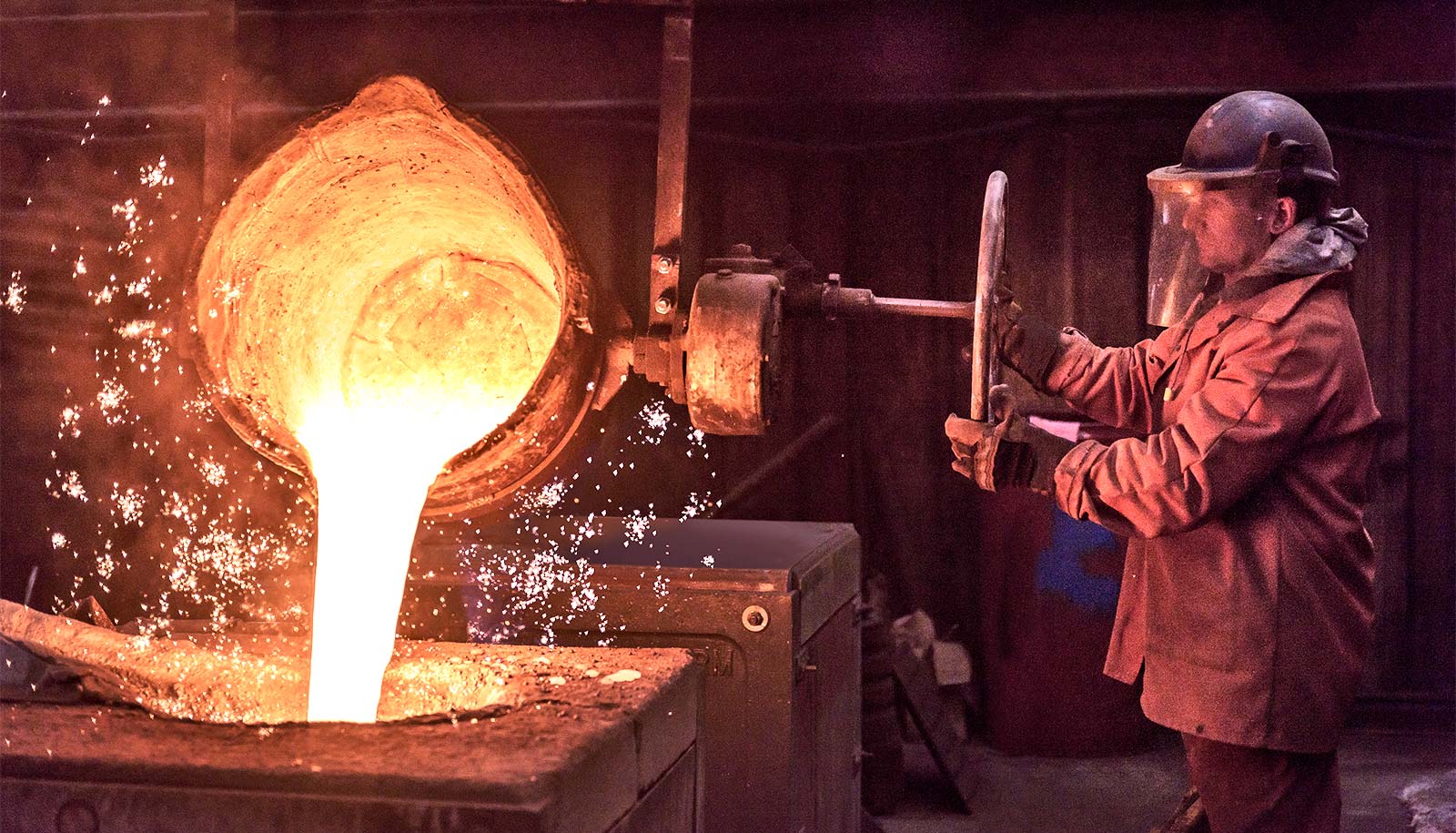Home>Science & Environment>Metal Melting Points: A Comprehensive Guide To The Melting Points Of Various Metals


Science & Environment
Metal Melting Points: A Comprehensive Guide To The Melting Points Of Various Metals
Published: February 19, 2024
Discover the melting points of various metals with our comprehensive guide. Explore the science and environment of metal melting points.
(Many of the links in this article redirect to a specific reviewed product. Your purchase of these products through affiliate links helps to generate commission for Temperatures.com, at no extra cost. Learn more)
Table of Contents
Introduction
Metal melting points play a crucial role in various industrial and scientific applications. Understanding the melting points of different metals is essential for processes such as metal casting, welding, and alloy production. The ability to manipulate metals at specific temperatures is fundamental to the creation of durable structures, intricate components, and innovative technologies.
The study of metal melting points is a fascinating exploration into the physical properties of elements and their behavior under varying conditions. It provides valuable insights into the thermal characteristics of metals, shedding light on their suitability for specific uses and environments. From the extreme heat resistance of refractory metals to the low melting points of certain alloys, the diverse range of metal melting points offers a rich tapestry of possibilities for engineers, scientists, and artisans alike.
In this comprehensive guide, we will delve into the factors that influence metal melting points, explore the melting points of common metals, and examine the applications of these properties in different industries. By gaining a deeper understanding of metal melting points, we can appreciate the remarkable versatility and utility of metals in our modern world.
Factors Affecting Metal Melting Points
The melting point of a metal is influenced by a variety of factors, reflecting the intricate interplay of atomic and molecular forces within the material. Understanding these factors is essential for predicting and manipulating the behavior of metals under different conditions. Here are the key factors that affect metal melting points:
-
Atomic Structure: The arrangement of atoms within a metal significantly impacts its melting point. Metals with a closely packed atomic structure tend to have higher melting points due to stronger metallic bonds. For example, transition metals such as iron, nickel, and copper exhibit high melting points owing to their dense and orderly atomic arrangements.
-
Atomic Size: The size of metal atoms also plays a crucial role in determining melting points. Smaller atoms can pack more closely together, leading to stronger metallic bonds and higher melting points. This is evident in metals such as tungsten and molybdenum, which have relatively small atomic sizes and consequently high melting points.
-
Valence Electrons: The number of valence electrons in metal atoms influences their bonding behavior and, consequently, their melting points. Metals with a greater number of valence electrons tend to form stronger metallic bonds, resulting in higher melting points. For instance, transition metals typically have multiple valence electrons, contributing to their elevated melting points.
-
Alloying Elements: The addition of alloying elements can significantly alter the melting point of a metal. By introducing foreign atoms into the metallic lattice, the cohesive forces between metal atoms are modified, leading to changes in the melting point. Alloying can either raise or lower the melting point, depending on the specific elements and their concentrations.
-
Crystal Structure: The crystalline arrangement of atoms in a metal, known as its crystal structure, influences its melting behavior. Metals can exhibit different crystal structures, such as body-centered cubic, face-centered cubic, or hexagonal close-packed, each of which imparts distinct melting characteristics to the material.
-
Pressure: While often overlooked, pressure can impact the melting point of metals. In general, an increase in pressure raises the melting point by stabilizing the solid phase. However, this effect varies among different metals and is more pronounced in certain materials, such as those with covalent or directional bonding.
By considering these factors, scientists and engineers can gain valuable insights into the behavior of metals at high temperatures, enabling them to make informed decisions regarding material selection, processing techniques, and the development of advanced metal alloys.
Common Metals and Their Melting Points
Understanding the melting points of common metals is essential for a wide range of industrial and scientific applications. Here, we explore the melting points of several widely used metals, shedding light on their thermal properties and practical significance.
-
Iron (Fe):
- Melting Point: 1538°C (2800°F)
- Iron, a fundamental building block of modern civilization, exhibits a relatively high melting point, making it suitable for structural applications, manufacturing, and alloy production. Its robustness at high temperatures has contributed to its extensive use in construction, machinery, and infrastructure development.
-
Aluminum (Al):
- Melting Point: 660.3°C (1220.5°F)
- Aluminum's relatively low melting point compared to other metals makes it highly versatile in various industries. Its lightweight nature and favorable melting characteristics have led to its widespread utilization in aerospace, automotive, and packaging sectors.
-
Copper (Cu):
- Melting Point: 1084.62°C (1984.32°F)
- Copper's moderate melting point, coupled with its exceptional conductivity and malleability, has positioned it as a vital material in electrical wiring, plumbing, and architectural applications. Its ability to withstand high temperatures makes it indispensable in electrical engineering and industrial processes.
-
Lead (Pb):
- Melting Point: 327.5°C (621.5°F)
- Lead's relatively low melting point has historically made it a favored material for casting, soldering, and radiation shielding. Its malleability at low temperatures has rendered it valuable in various manufacturing and construction endeavors.
-
Nickel (Ni):
- Melting Point: 1455°C (2651°F)
- Nickel's high melting point, combined with its corrosion resistance and magnetic properties, has established its prominence in the production of stainless steel, aerospace components, and advanced engineering alloys. Its resilience at elevated temperatures makes it indispensable in demanding industrial environments.
-
Zinc (Zn):
- Melting Point: 419.53°C (787.15°F)
- Zinc's relatively low melting point has positioned it as a crucial element in galvanization, die-casting, and battery manufacturing. Its ability to undergo controlled melting and solidification processes has made it a cornerstone of modern metallurgy and industrial applications.
Understanding the melting points of these common metals provides valuable insights into their suitability for specific uses, enabling engineers, designers, and manufacturers to make informed decisions regarding material selection, processing techniques, and product development. The diverse range of melting points among these metals underscores the remarkable versatility and adaptability of metals in various industrial and technological domains.
High Melting Point Metals
Metals with exceptionally high melting points exhibit remarkable thermal stability and resilience, making them indispensable in demanding industrial, scientific, and technological applications. These high melting point metals possess the extraordinary ability to withstand extreme temperatures without undergoing phase transitions, enabling them to maintain their structural integrity and functional properties under challenging conditions.
One of the most renowned high melting point metals is tungsten (W), which boasts a staggering melting point of 3422°C (6192°F). This exceptional thermal stability has positioned tungsten as a critical material in high-temperature environments, such as aerospace propulsion systems, electrical components, and industrial furnaces. Its robustness at extreme temperatures makes it an ideal choice for applications requiring exceptional heat resistance and mechanical strength.
Another notable high melting point metal is rhenium (Re), characterized by its remarkable melting point of 3186°C (5767°F). Rhenium's exceptional thermal properties have led to its widespread use in aerospace and aviation technologies, where it serves as a vital component in high-temperature engine parts, turbine blades, and exhaust nozzles. Its ability to withstand intense heat and mechanical stress has elevated the performance and durability of critical aerospace systems.
Molybdenum (Mo) is also recognized for its high melting point of 2623°C (4753°F), rendering it invaluable in diverse industrial applications. Its exceptional thermal conductivity, corrosion resistance, and strength at elevated temperatures have established molybdenum as a key material in the production of high-strength alloys, electrical contacts, and heat-resistant components for glass manufacturing and furnace construction.
Furthermore, tantalum (Ta) exhibits a remarkable melting point of 3017°C (5462°F), making it an essential element in high-temperature electronics, chemical processing equipment, and medical implants. Tantalum's exceptional resistance to corrosion and heat, coupled with its biocompatibility, has positioned it as a critical material in advanced electronic components, superalloys, and biomedical devices, where reliability and performance under extreme conditions are paramount.
The exceptional thermal stability and robustness of these high melting point metals underscore their pivotal role in enabling technological advancements, enhancing industrial capabilities, and pushing the boundaries of scientific exploration. By harnessing the unique properties of these metals, engineers, researchers, and innovators continue to unlock new possibilities in aerospace, energy, materials science, and beyond, driving progress and innovation in diverse fields.
The remarkable resilience and thermal stability of high melting point metals exemplify the extraordinary capabilities of metallic materials, offering a testament to the enduring legacy of metals as indispensable resources in our modern world.
Low Melting Point Metals
Low melting point metals exhibit distinctive thermal characteristics that make them invaluable in a wide array of industrial, artistic, and technological applications. These metals, with their relatively low melting temperatures, offer unique properties that enable them to be easily manipulated, cast, and alloyed, opening up diverse possibilities for creative expression and functional innovation.
One of the most prominent low melting point metals is lead (Pb), renowned for its melting point of 327.5°C (621.5°F). This relatively low melting temperature has historically made lead a favored material for casting, soldering, and radiation shielding. Its malleability at low temperatures has rendered it valuable in various manufacturing and construction endeavors, from crafting intricate sculptures to creating intricate stained glass windows.
Another notable low melting point metal is tin (Sn), characterized by its melting point of 231.93°C (449.47°F). Tin's low melting temperature has positioned it as a crucial element in soldering, plating, and the production of various alloys. Its ability to form low-melting-point eutectic alloys with other metals has made it indispensable in electronics, plumbing, and culinary utensils, showcasing its versatility and adaptability in diverse applications.
Furthermore, bismuth (Bi) is recognized for its low melting point of 271.4°C (520.5°F), making it a vital component in low-temperature applications, such as fire sprinkler systems, fusible alloys, and pharmaceutical formulations. Bismuth's unique property of expanding upon solidification has led to its use in precision casting, thermal regulation devices, and innovative materials with controlled thermal expansion characteristics.
Additionally, gallium (Ga) exhibits a remarkably low melting point of 29.76°C (85.57°F), rendering it a fascinating metal with unconventional applications. Gallium's ability to liquefy in the palm of a hand has led to its use in innovative technologies, such as thermal management systems, temperature-sensitive switches, and advanced electronics. Its low melting point has also made it a popular element for educational demonstrations and scientific experiments, captivating the imagination of students and researchers alike.
The exceptional properties of these low melting point metals, from lead's malleability to gallium's liquid state at room temperature, highlight the diverse and captivating nature of metallic materials. By harnessing the unique characteristics of these metals, artisans, engineers, and innovators continue to explore new frontiers in material design, manufacturing, and artistic expression, demonstrating the enduring relevance and versatility of low melting point metals in our modern world.
Applications of Metal Melting Points
The understanding of metal melting points is integral to a myriad of industrial, scientific, and artistic applications. The precise control and utilization of metal melting points underpin the creation of durable structures, intricate components, and innovative technologies across diverse domains. Here are some key applications of metal melting points:
Metallurgy and Manufacturing:
In metallurgical processes, the knowledge of metal melting points is essential for the production of alloys with specific mechanical, thermal, and electrical properties. By carefully selecting and combining metals based on their melting points, engineers can tailor the characteristics of alloys to meet the requirements of various applications, ranging from automotive components to aerospace materials. Additionally, in manufacturing, the manipulation of metal melting points enables the casting, forging, and shaping of metallic parts and products, contributing to the advancement of industrial capabilities and product innovation.
Welding and Joining:
The precise control of metal melting points is critical in welding and joining processes, where the fusion of metals is achieved through localized melting and solidification. By understanding the melting behavior of different metals, welders and fabricators can effectively join components, structures, and pipelines, ensuring strong and durable connections. The selection of welding techniques and filler materials based on metal melting points plays a pivotal role in creating reliable and resilient joints in diverse applications, from construction and infrastructure to automotive and shipbuilding.
Heat-Resistant Materials:
In high-temperature environments, materials with elevated melting points are indispensable for the construction of furnaces, kilns, and thermal insulation systems. Metals with high melting points, such as tungsten, molybdenum, and rhenium, are utilized in the production of heat-resistant components, electrical contacts, and aerospace propulsion systems. Their exceptional thermal stability enables the development of advanced materials capable of withstanding extreme temperatures, contributing to the efficiency and safety of industrial processes and technological advancements.
Read more: June Weather In NYC: A Comprehensive Guide
Artistic and Creative Expression:
The manipulation of low melting point metals, such as lead, tin, and bismuth, has long been embraced by artists and craftsmen for the creation of sculptures, jewelry, and decorative objects. The ability to cast and mold these metals at relatively low temperatures allows for intricate and expressive designs, showcasing the artistic potential of metal melting points. Furthermore, the use of low melting point alloys in casting and modeling applications provides artists with a versatile medium for realizing their creative visions, adding a touch of elegance and allure to diverse art forms.
Scientific Research and Exploration:
In scientific laboratories and research facilities, the study of metal melting points contributes to the development of advanced materials, experimental techniques, and fundamental understanding of material behavior. Researchers leverage the knowledge of metal melting points to explore phase transitions, solidification processes, and the thermal properties of metals under extreme conditions. This knowledge fuels scientific discovery and innovation, paving the way for breakthroughs in materials science, metallurgy, and physical chemistry.
The applications of metal melting points extend across a wide spectrum of industries, disciplines, and creative endeavors, shaping the way we design, manufacture, and interact with metallic materials. By harnessing the unique properties of metals at different melting points, we continue to push the boundaries of technological innovation, artistic expression, and scientific exploration, unlocking new possibilities and shaping the future of material science and engineering.
Conclusion
The exploration of metal melting points unveils a captivating tapestry of scientific, industrial, and artistic significance, showcasing the remarkable versatility and utility of metallic materials. From the high melting points of refractory metals to the low melting points of fusible alloys, the diverse range of metal melting points underpins a myriad of applications, shaping the landscape of modern engineering, manufacturing, and creative expression.
The understanding of factors influencing metal melting points, including atomic structure, atomic size, valence electrons, alloying elements, crystal structure, and pressure, provides a profound insight into the behavior of metals at elevated temperatures. This knowledge empowers scientists, engineers, and artisans to make informed decisions regarding material selection, processing techniques, and the development of advanced metal alloys, driving progress and innovation across diverse industries.
The significance of metal melting points is exemplified in their applications, ranging from metallurgy and manufacturing to welding, heat-resistant materials, artistic expression, and scientific research. The precise control and utilization of metal melting points enable the creation of durable structures, intricate components, and innovative technologies, contributing to the advancement of industrial capabilities, artistic creativity, and scientific exploration.
As we continue to unravel the intricacies of metal melting points, we uncover new possibilities for material design, manufacturing processes, and technological advancements. The resilience of high melting point metals in extreme environments, the malleability of low melting point metals in artistic endeavors, and the transformative potential of alloys tailored to specific melting characteristics all underscore the enduring relevance and adaptability of metallic materials in our modern world.
In conclusion, the study of metal melting points serves as a testament to the enduring legacy of metals as indispensable resources, driving progress and innovation in diverse fields. By harnessing the unique properties of metals at different melting points, we continue to push the boundaries of technological innovation, artistic expression, and scientific exploration, unlocking new possibilities and shaping the future of material science and engineering.













